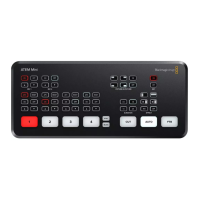After you have normalized all your input levels, you can now begin optimizing and shaping the
qualities in each audio input using the6 band parametric equalizer and dynamics controls.
Delay Control
Sometimes when using analog audio via your ATEM Mini’s mic inputs, there may be a slight
difference in the sync between analog audio and video. For example, the analog audio may
sound slightly ahead of the video. This is because analog audio is independent of the video
inputs and is coming directly from an external source, while the HDMI inputs might have some
delay depending on upstream equipment, such as some cameras and video processors.
Setting the audio delay will ensure the analog audio input is perfectly AV synced to the video
inputs from cameras.
To adjust the amount of delay on the selected input:
1 Click on the delay indicator beneath the input audio level control knob on the
channel strip.
Click on the delay indicator below the level
input knob to open the delay control.
A small popup window will open containing the delay adjustment knob.
2 Click on the delay knob and drag left to decrease the amount of delay, or drag right to
increase. The amount of delay is measured in frames. Close the window by clicking on
the small ‘x’ in the top corner, or move the window to a safe place on your desktop if
you need to make further adjustments later.
Click on the delay control and drag left or
right to decrease or increase the amount
of delay required for an analog input
Using the 6 Band Parametric Equalizer
Each input and the master output has a 6 band parametric equalizer which can be used to
control specific frequencies. This could include reducing low frequency hum or noise on a
microphone input, or boosting the low frequencies on a thin sounding track, or even to add
uniqueness to each input so they are more distinct in the final mix. You have many
creative options.
63ATEM Software Control

